Volkswagen Amarok Style TDI500 2024 review
Volkswagen’s mid-range Amarok Style variant shows you don’t need spend more to get one of the most accomplished ute packages on the market
Let’s face it: the ute market in Australia isn’t going to slow up any time soon.
BYD will launch its first-ever ute, the plug-in hybrid Shark 6, before the end of 2024, while Kia’s highly anticipated Tasman ute will be with us in 2025.
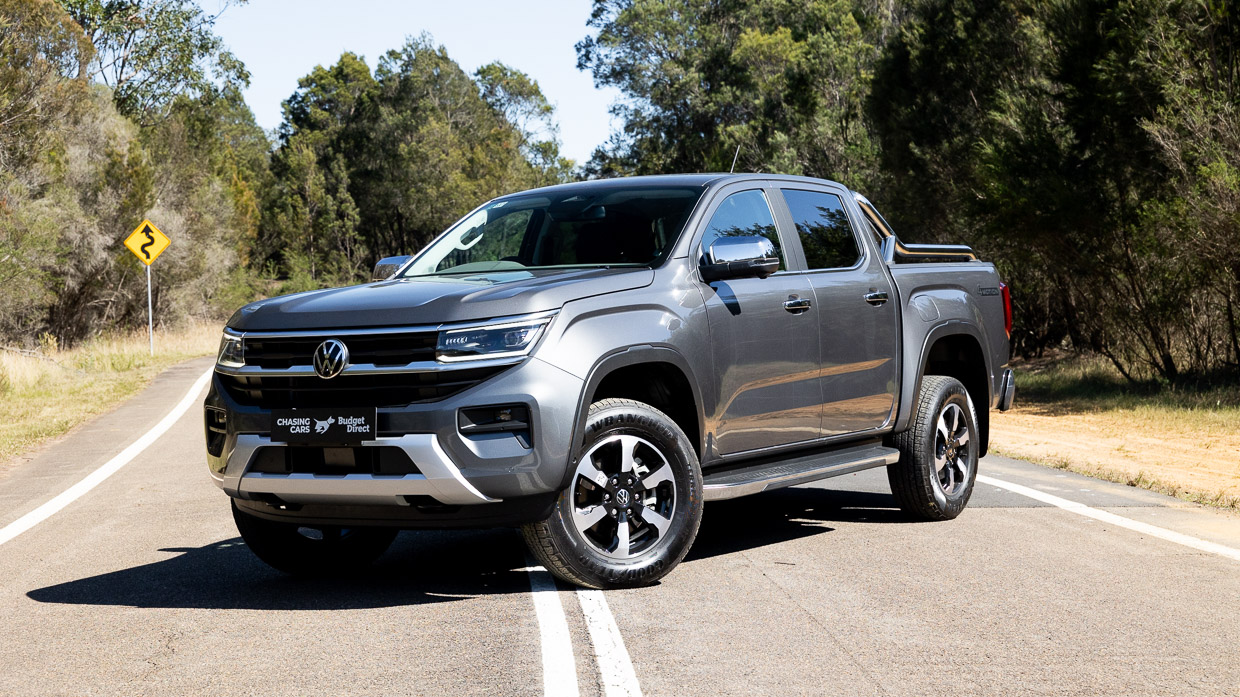
Currently, there are 14 brands battling it out in our utility/ute/pickup market. And while you may have the two heavy sales hitters in front of mind – the Ford Ranger and Toyota Hilux – there is still plenty of breadth and variety in the alternatives. From body style type to a range of price brackets, there ought to be a ute for almost everyone.
When global automaker Volkswagen partnered up with Ford to build the latest Amarok ute, the brand set out to reinvent its particular pickup spin.
When I first drove the current Amarok, it was a Panamericana variant, and I loved it. Since then, I’ve been able to drive almost every iteration in the lineup, including the Core, Life, Aventura and now, for this review, the Style variant.

So that puts me in a good position to assess whether buyers need to spend big money on highly specified Amaroks, or might you be happy with the mid-spec Style instead, on test here in four-pot TDI500 guise?
Could the Style be the sweet spot of the entire range? We drove the Amarok Style TDI500 extensively, including touring the Sydney Spring Drive Day with Drive Against Depression, to find out.
What are the Amarok Style’s features and options for the price?
For this test, we were given the keys to a Style TDI500 which is currently priced at $70,990 driveaway.
You can get a 3.0-litre V6 oiler powered TDI600 powertrain in Style trim for a $5000 premium, or from $75,990 driveaway before options.
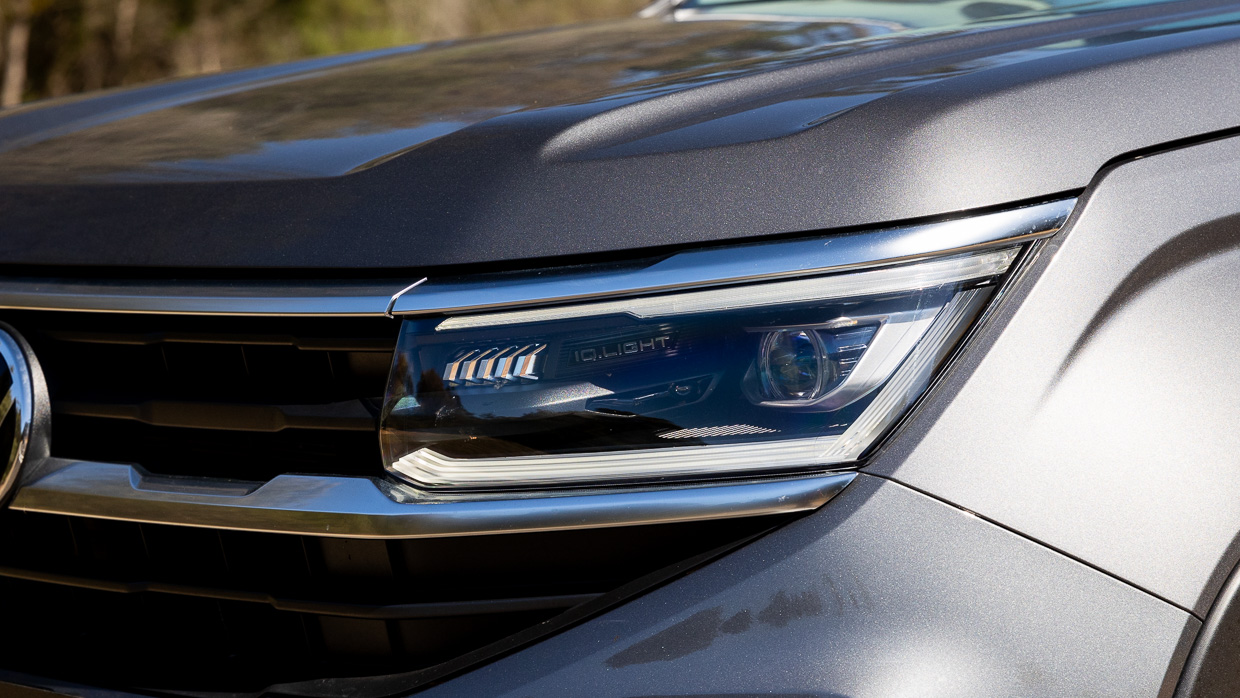
As standard, the Amarok Style gains the following features:
- 12.0-inch centre portrait touchscreen
- 12.3-inch digital cockpit/instrument cluster
- LED IQ Light Matrix headlights
- 18-inch alloy wheels
- Highway-terrain tyre
- 3.5-tonne tow bar
- Leather wrapped steering wheel
- Stainless-steel rear sports bar
- 10-way power driver’s seat
- ArtVelours microfleece upholstery
- Mechanical differential lock

Braked towing 3500kg, while the payload in the tub is 1009kg.
As for options, our Style had optional Dark Grey Metallic paintwork, one of seven premium paint hues that cost an additional $1100. Solid white is no cost. Inside, Ebony Black & Grey upholstery is included at no cost.
Volkswagen also has an extensive genuine accessories range including canopies, bull bars, drawer systems, dual battery systems, recovery kits, roof racks and even rooftop tents.
How does the Amarok Style drive?
When the Amarok came into the Chasing Cars garage in the same week as my latest Drive Against Depression charity drive day adventure, I wasn’t expecting to take a great big ute up the steep and winding Macquarie Pass, near Wollongong, south of Sydney.
Usually, utility vehicles and corner carving do not mix, but then I remembered that the Amarok is one of the best utes to drive in the segment. You may think that’s odd, but I’ll try my best to explain why.

The TDI500 has the 2.0-litre bi-turbo four-cylinder engine that produces 154kW and 500Nm. This engine is also available in the very-related Ford Ranger and has been for some time.
The turbo-diesel four is paired to a ten-speed automatic transmission that sends all that grunt to a part-time four-wheel-drive system.
Saddling up in the Amarok and driving about for the first time, I am reminded just how car-like this ute is. I’ve spent the last two months driving all sorts of utes and, to compare, the Amarok sets the standard for ride quality and refinement.

Volkswagen has been able to do the seemingly improbable: make a leaf-sprung ute ride a lot like that of a passenger vehicle. It’s controlled and well damped and felt comfortable day in and day out.
And while there is some obvious body roll, the Amarok handles with surprising levels of poise.
Having been the custodian of a Ford Ranger Wildtrak V6 long-termer, I thought the transition to the ‘family’ four-cylinder bi-turbo four would be a noticable step down. Instead, I was pleasantly surprised at the response from the four-pot oiler.
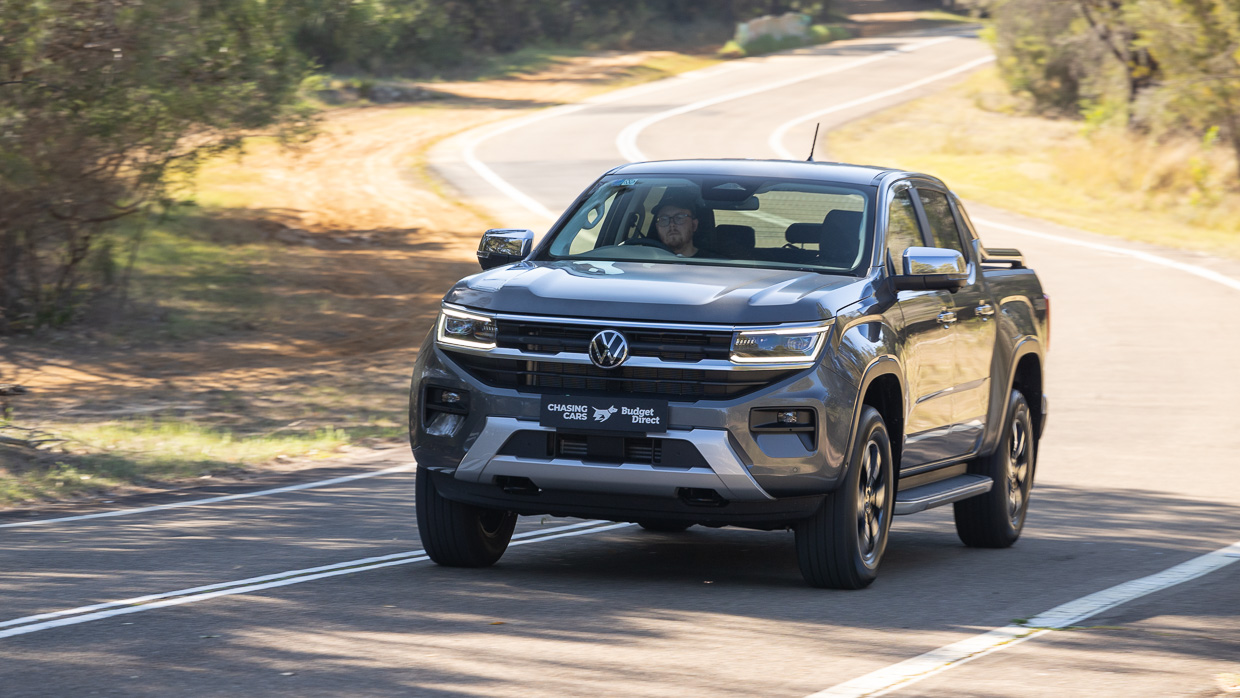
And while it might not be as smooth as the silky, quiet and somewhat lustier V6 diesel, the bi-turbo gets the job done without musch fuss or sweat and is a little bit more frugal while doing so.
Get the Amarok up to speed on the highway and the ute falls into a nice rhythm. The engine is quiet and hums away quite softly, while the transmission finds its natural resting place.
On our drive to Bowral via the Macquarie Pass, the Amarok kept up with the pack and was actually pretty fun to drive. Who said dual-cabs couldn’t be entertaining within reason?
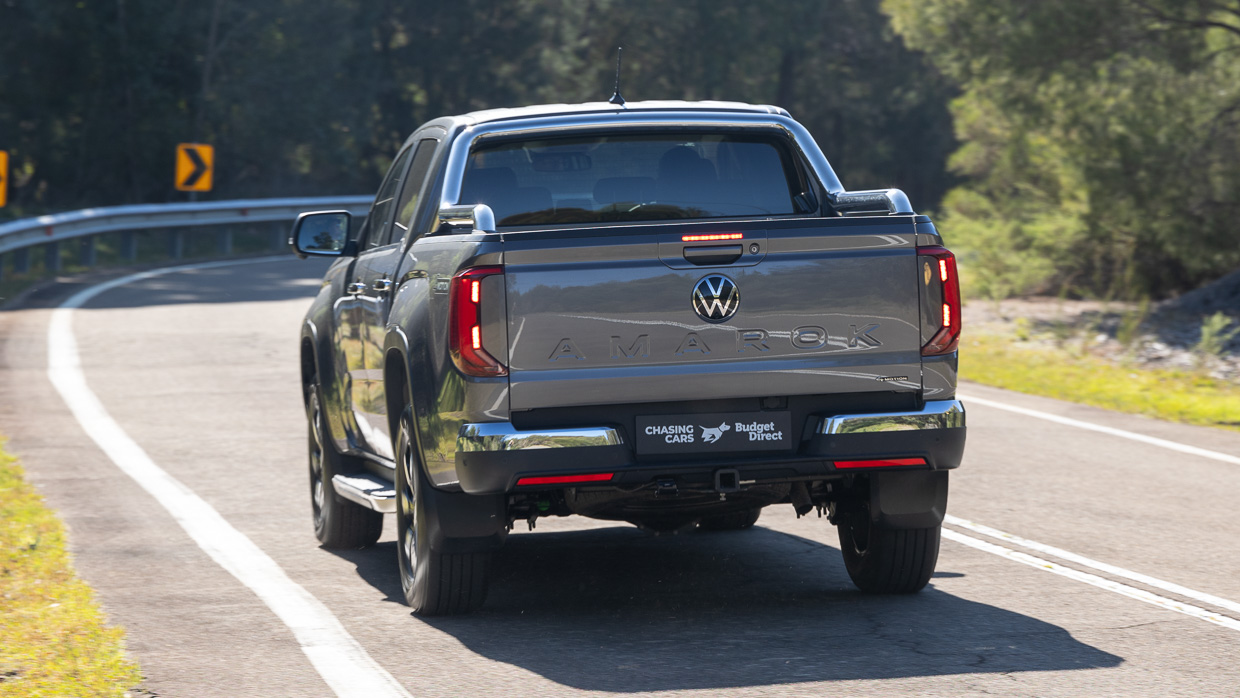
Last year, I attended the launch of the Amarok Core and Life models – the more basic variations in the Amarok family tree – and both variants tackled some serious off-roading challenges with confidence and ease.
Now, as I jump up the ladder to the Style, the Amarok recipe remains the same: ease of use off-road, plenty of power to get through the tough stuff, and plenty of confidence.
We finished the DAD drive in Bowral and I honestly walked away from the Amarok Style after three hours at the wheel with a definite sense of respect for the ute and its capabilities on and off road.
What is the Amarok Style’s interior and tech like?
Volkswagen sure does know how to do an interior. And that extends to bring a sense of solidity and class to a segment that so often lacks for them.
I’m immediately drawn to the Style’s ArtVelours contrast interior trim, the choice of cabin materials, the well-bolstered front seats and the smorgasbord of standard tech.
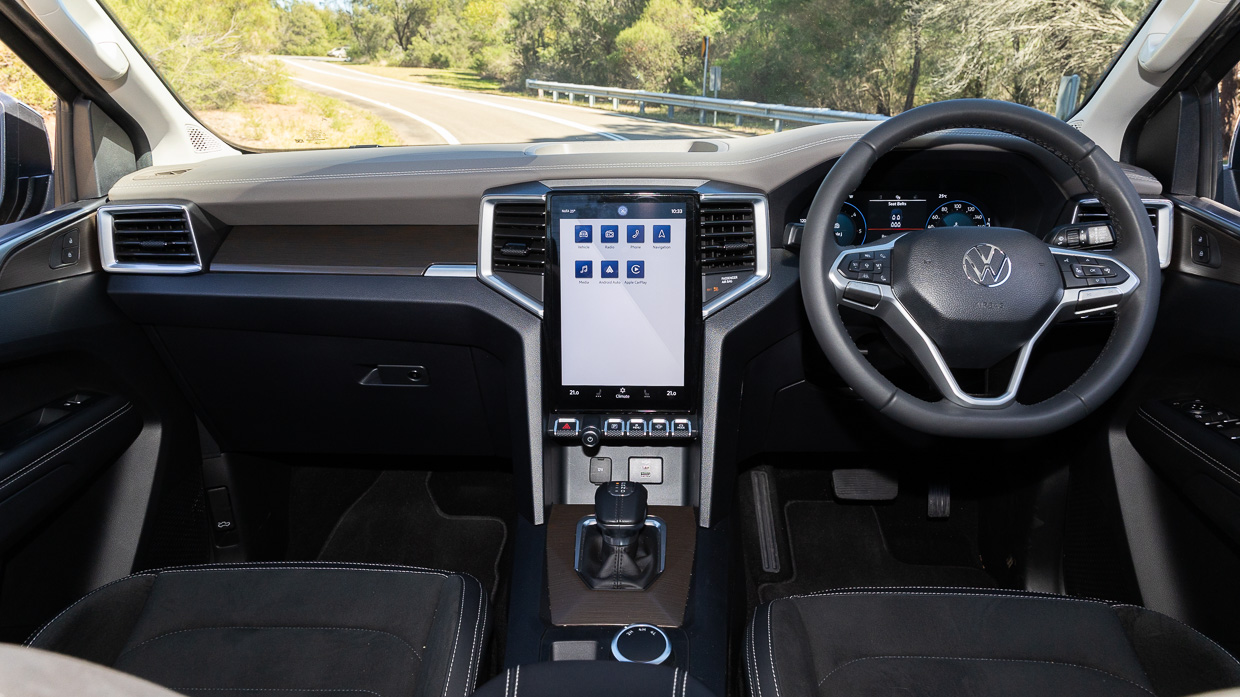
Not only does the Amarok Style feel well built, it feels like it would last even the toughest and roughest of treatment. The lack of leather upholstery, as fitted to the Panamericana one rung up the range, actually doesn’t bother me; the Style feels premium even without any cow hide in the interior.
One particular highlight of the cabin are the front seats. Not only are they comfortable, but they are also supportive, well bolstered and don’t hurt your back even after a few hours on the road.
It’s a good seating position, too, with more of a sitting in the car, rather than on the car vibe.
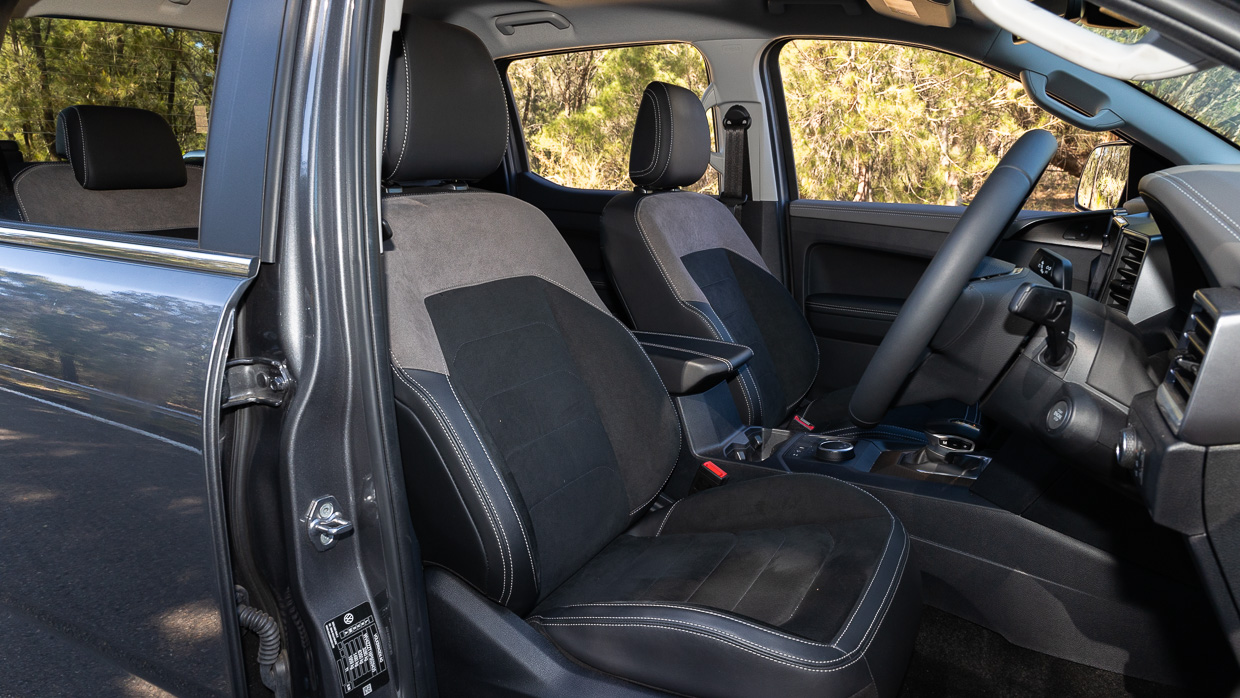

It’s worth noting that Amarok Style buyers will gain electric adjustment for the driver’s seat, but only manual adjustment for the front passenger.
As for technology, the key cabin highlight is the large 12-inch centre touchscreen that runs wireless Apple CarPlay and Android Auto. If you compare it to a Ford Ranger, you won’t get a 12-inch screen until the Wildtrak grade, so for the Amarok to have this feature halfway up the family tree is a big tick.
However, Volkswagen has chosen to put the climate control inside the screen, rather than having physical climate control buttons like what is found in the Ford Ranger. The Ford design is simply better to use.
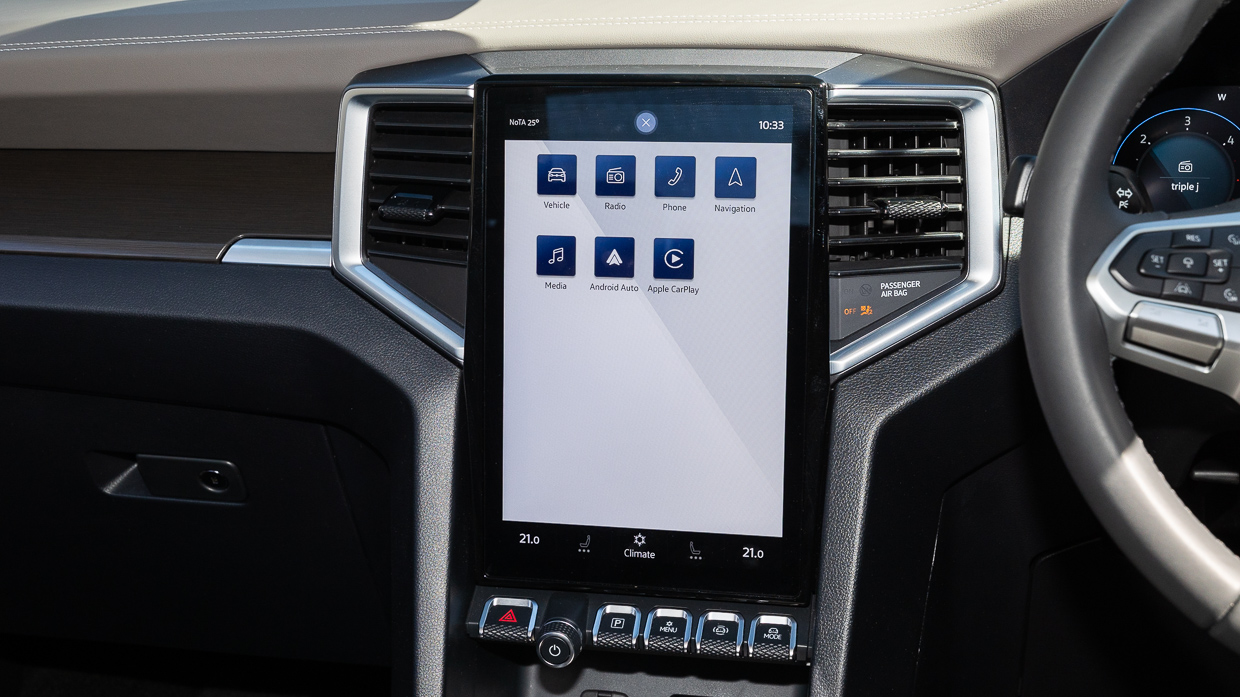

Despite this annoyance, the Amarok’s core screen is largely a pleasure to use. The only other notable downside is the lack of a physical auto start/stop button, which is instead buried in sub menus…again, unlike the easily accessible dedicated console button in Ranger.
For the driver, the Amarok Style provides more control over settings thanks to a 12.3-inch digital cockpit.
Here, you can adjust settings on the fly thanks to the steering wheel buttons, as well as monitor tyre pressure monitoring and more. Like the touchscreen, this is a nice clean and clear screen and is of high quality.

In the second row, things are a little more squishy, however it’s a suitable space for adults to ride back there for moderate journeys.
Other convenience features such as a 12-volt port and air vents feature, however there is a lack of USB-C or USB-A ports in the second row.
In the tray, dimensions back there are 1544mm long by 1224mm wide. There is a power socket to power tools or a fridge, but no flexible mounting rack system like what you’d find in a Nissan Navara.
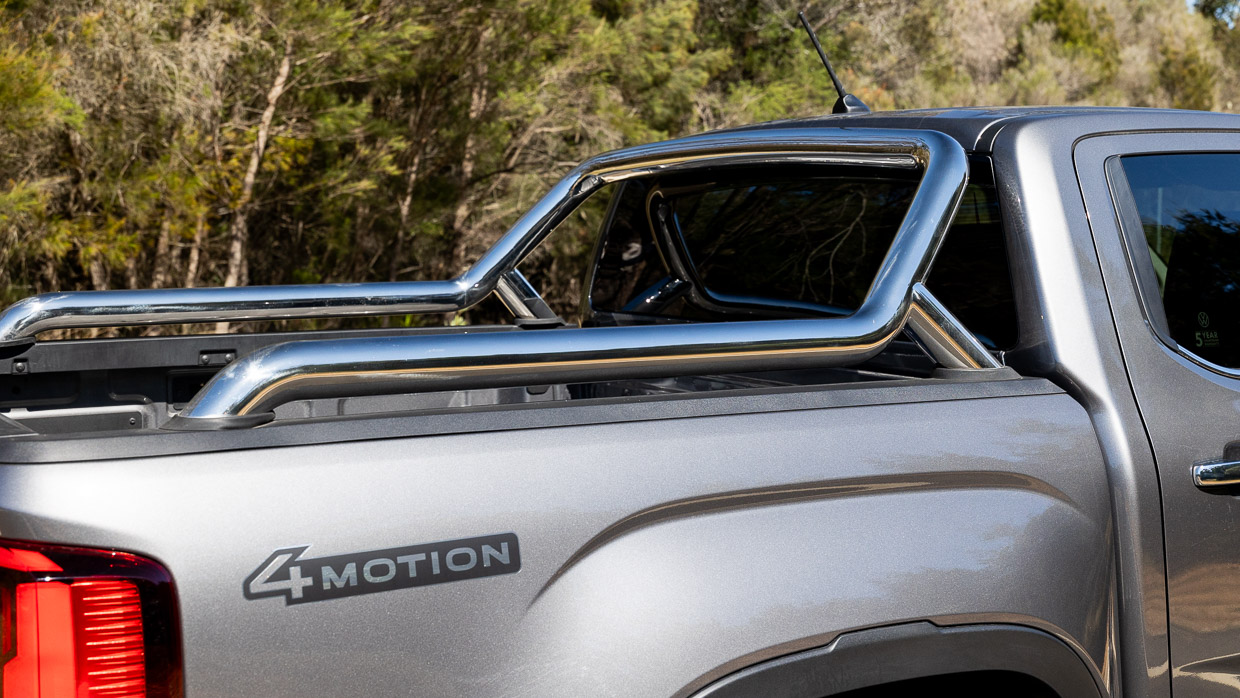
The Style gains a stainless steel sports bar, though there’s no tubliner or damped tailgate functionality in this grade.
All in all, the Amarok Style offers plenty of technology, practicality and, yes I’ll say it, style, in the ute market in 2024.
Is the Amarok Style a safe car?
The Volkswagen Amarok dual-cab variants currently hold a five-star ANCAP safety rating.
In assessment, the ute returned a 86 percent adult occupant protection score, a 93 percent child occupant score, 74 percent for vulnerable road user protection and 83 percent for safety assist.
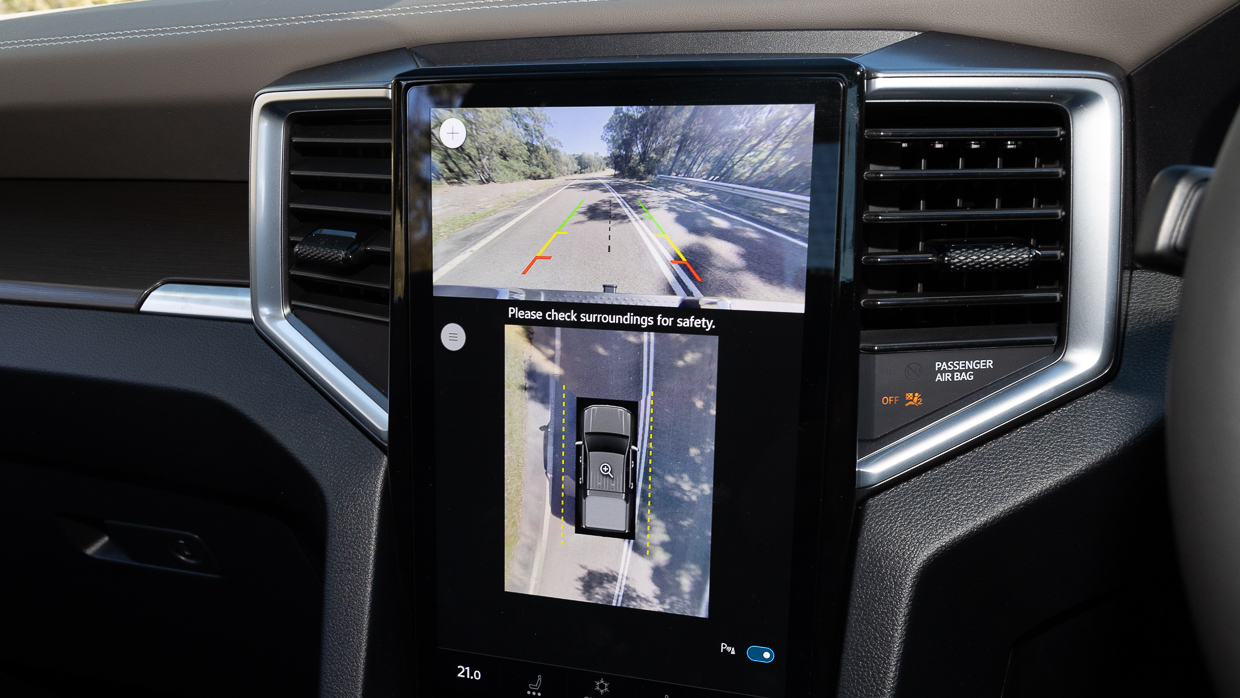
As standard, the Amarok is fitted with the following safety features:
- Nine airbags
- Parking assist
- Tyre pressure monitoring
- Intelligent speed limiter
- Speed sign recognition
- Adaptive cruise control
- Lane keeping assist
- Multi-collision brake
- Rain sensing wipers
- Front and rear parking sensors
- 360-degree camera
- Blind spot monitoring
But how does this all work in the real world? The Amarok seemed to be fairly well tuned, with the lane keep assist easy to switch off with just two presses of one of the steering wheel buttons.

I found the parking sensors to be a little too sensitive and a little overprotective for my personal tastes, but these can be obviously switched off in the settings menu.
What are the Amarok Style’s ownership costs?
As is the case for all new Volkswagens sold in Australia, the Amarok is offered with a five-year, unlimited-kilometre warranty.
With a Volkswagen care plan, servicing the Amarok Style will cost $1900 over a five-year period. Service intervals are set at 15,000 kilometres or 12 months, whichever occurs first.

The bi-turbo Amarok Style has an official combined fuel efficiency of 7.2L/100km but in the real world, after almost 500 kilometres travelled, we saw roughly 8.4L/100km across a range of different driving environments and situations.
The honest verdict on the Amarok Style
I come back to my original questions: do you need to buy the most expensive Amarok and is the Style the pick of the range?
I definitely think so. Despite not being the cheapest ute in the range (or segment), the Style offers power, practicality, car-like ride quality and a lifestyle focus that would suit a lot of Aussie buyers.

However, it’s not perfect. The Amarok remains on the pricey side of the segment, Style included. It’s not particularly fuel efficient as is claimed in bi-turbo form, and not that more frugal than the 3.0L V6. And it has some niggling annoyances, like the buried climate control functions.
With all that being said, the Volkswagen Amarok remains one of the best utes you can buy in Australia.
Sure, there are more utes on their way, but the Amarok should be able to fight them off.
Lexus GX550 Overtrail 2025 review: Australian test
1 year ago

Lexus takes a huge swing at the new Prado platform with the new GX off-roader – and, with few exceptions, the rugged yet refined result is a home run
Good points
- Turbo V6 has stacks of grunt
- Charismatic styling
- Sorted steering and handling
- Premium-grade cabin materials
- Useful size – it’s not too big
- Relative value over Prado
Needs work
- Big 15L/100km thirst…
- …and small 80L fuel tank…
- …means range is limited
- Lacks LX’s V6 diesel option
- Some missing interior spec
- Frequent maintenance
In bringing the rugged, Toyota Prado-sized GX to Australia for the first time, Lexus has solved one big problem – but it’s left another issue on the table to (perhaps) fix later.
Good news first: releasing the GX shows Lexus has discovered its charisma. Just look at the thing: the styling is unashamedly square, muscular, and confident – and yet yet somehow not alarmingly aggressive in execution like so many large vehicles. The Lexus GX is obviously cool. It doesn’t need to shout about it.
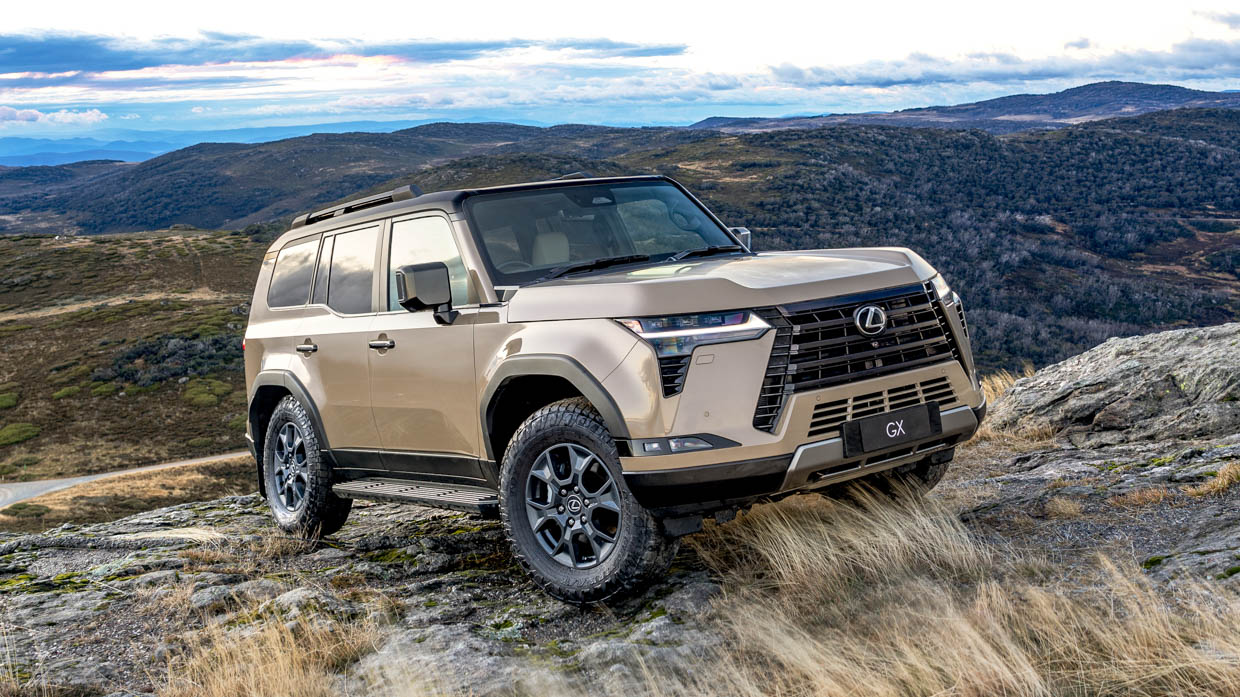
Bad news? Well…the GX is supposed to fill two roles in Australia. First, it adds the GX as a second serious 4WD (with body-on-frame construction and low-range transfer case) to the Lexus lineup for buyers that crave authenticity in their SUV.
But it’s also the replacement, of sorts, for the departed RX L seven-seat SUV – in other words, Lexus’s only halfway-justifiable three-row vehicle. The larger LX does have a wayback row, but it starts at $155,976.
The issue is that by making the GX a true four-wheel drive, mechanically dedicated to taking on genuinely difficult terrain, the space left over for the third row is frankly tiny. As a result, Lexus just does not have an answer to the likes of the Audi Q7 or Volvo XC90.
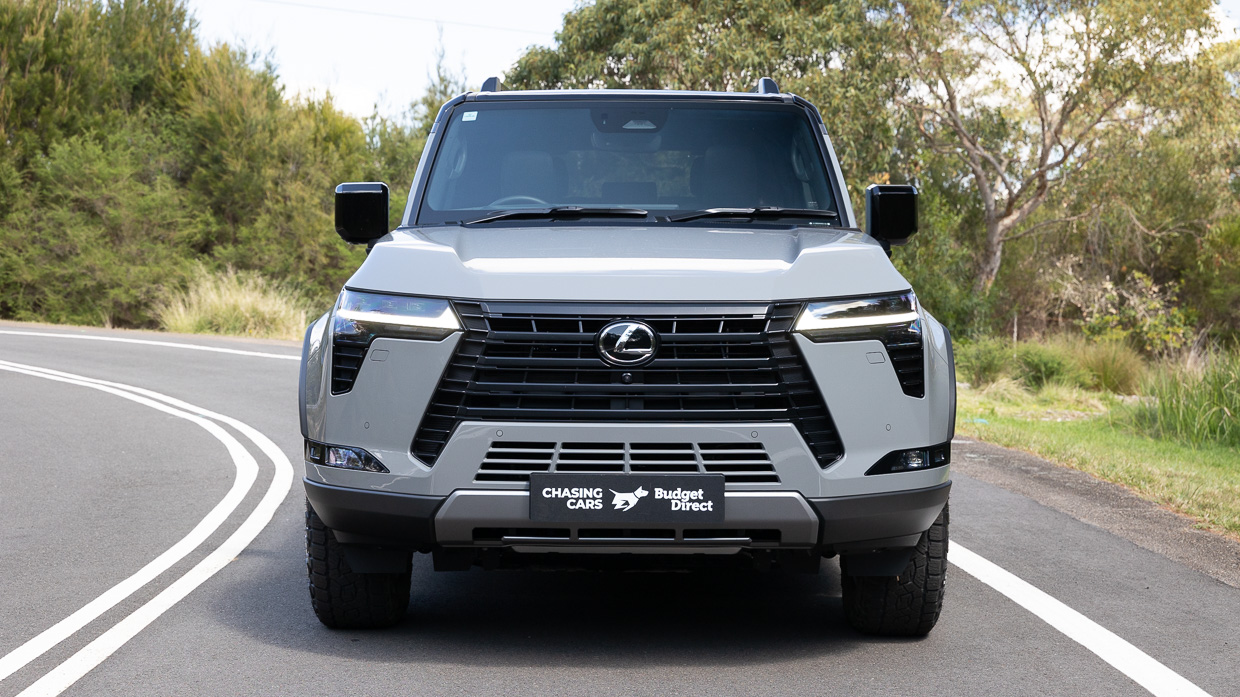
Which is why it’s refreshing, in a way – or at least honest – that the coolest-looking GX, the Overtrail trim on test, doesn’t even pretend to offer a third row. The most dialled-in version of the new Lexus, with extreme out-of-the-box capability, is a dedicated five-seat vehicle.
And it’s just landed in Australia, ready for testing on local roads and trails. Priced at $122,250 list (or about $139,000 driveaway as tested in two-tone paint), it slots into direct contention against the likes of the Land Rover Defender – or a larger, but lower-end, Land Cruiser 300 Series.
Sharing many of its 250 Series underpinnings with the forthcoming, as-yet unreleased Toyota Prado, the GX offers Land Cruiser faithful an interesting alternative that uses a beefy turbocharged V6 powertrain (easily eclipsing a Prado diesel), yet in a considerably more wieldy size than the six-cylinder 300 Series and LX models.
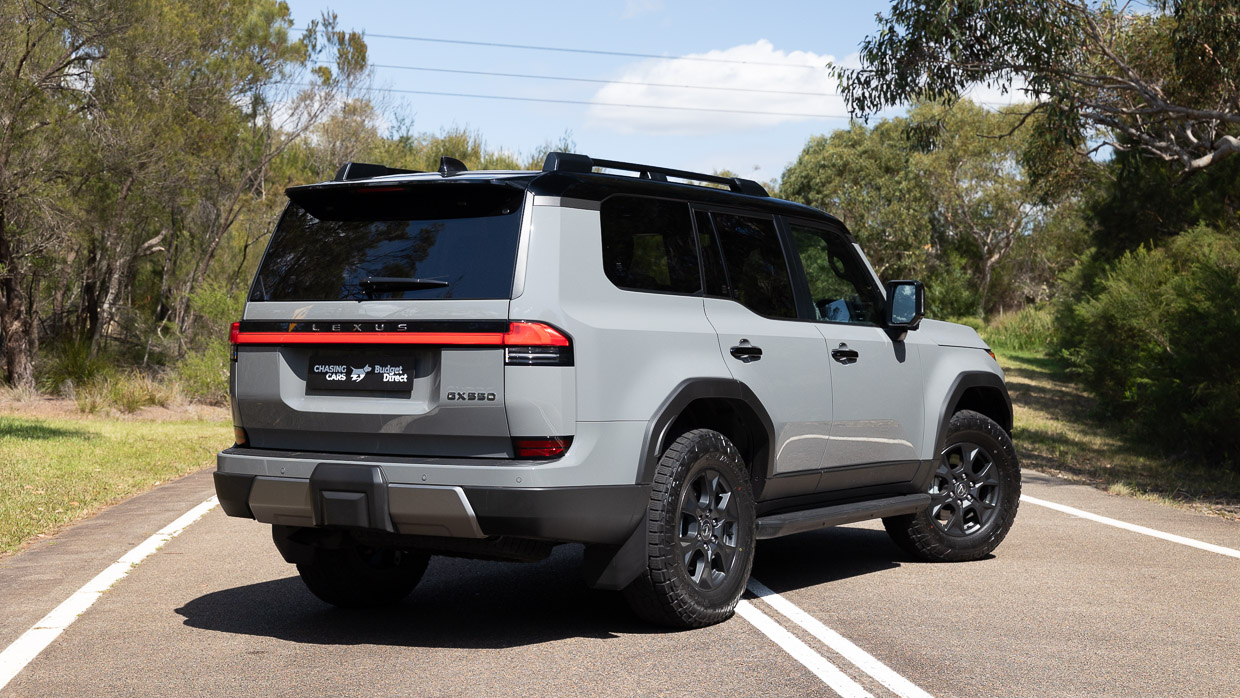
This isn’t our first meeting with GX: we drove a prototype near Mt Fuji, Japan, and then a production US-market car in the Sonora Desert of Arizona, USA. But there is no substitute to a full test, in right-hand-drive form, on Australian terrain. And it just so happens that the GX shone brighter locally than it did in either foreign environment.
So, who should consider the GX, and why do we think this vehicle is one of the strongest Lexus releases in many years? Read on…
What are the GX550 Overtrail’s features and options for the price?
First, it’s important to put the pricing of the Lexus GX in context. While no version of the new model is ‘cheap’, the GX has clearly been positioned to create a ‘bridge’ between high-end Prados and either a posh Land Cruiser 300 Series or a base model Lexus LX.
Consider the following list of vehicles from this segment and those around it:
- Lexus LX500d (base model): $155,976
- Lexus GX550 Overtrail: $122,250
- Toyota Land Cruiser (300 Series) VX: $120,991
- Ineos Grenadier Station Wagon Fieldmaster: $118,000
- Land Rover Defender 110 P400 X-Dynamic SE: $114,165
- Nissan Patrol Warrior: $105,160
- Toyota Land Cruiser Prado (250 Series) Kakadu: $99,990
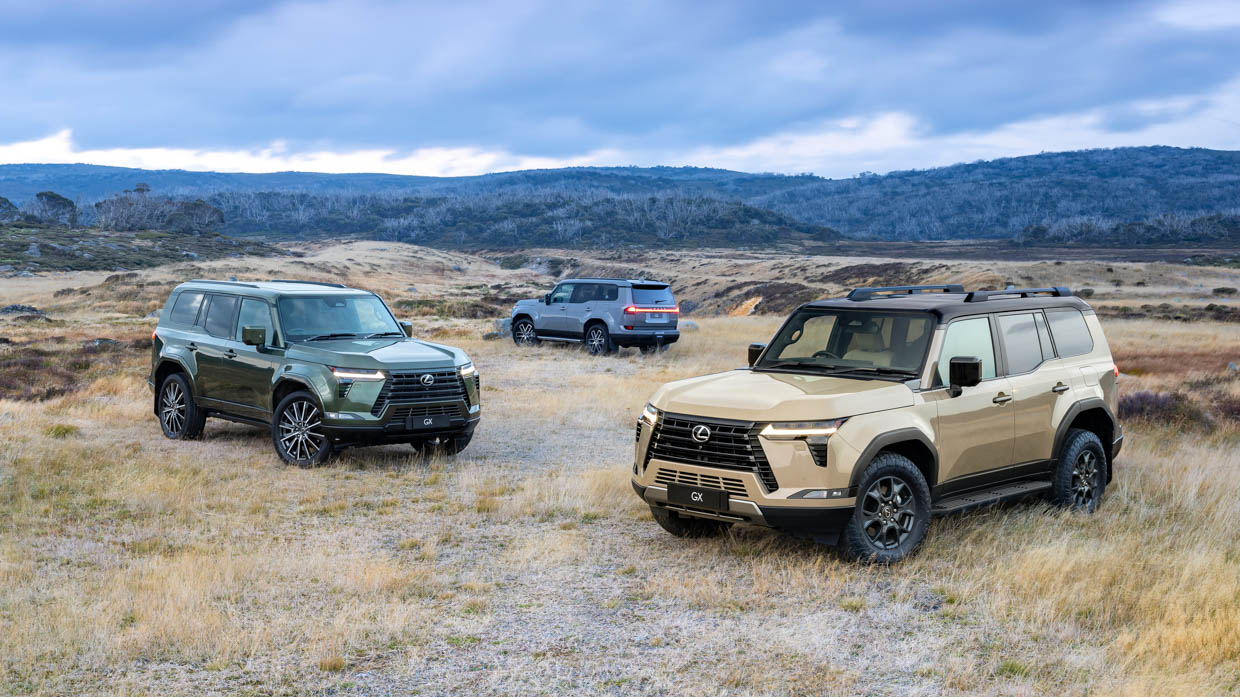
I’ll also point out that some buyers might also cross-shop the GX – as one of the large Lexus SUVs – against some car-based options that have significantly less hardcore off-road capability but superior on-road manners:
- Mercedes-Benz GLE300d: $146,900
- BMW X5 xDrive30d xLine: $134,900
- Audi Q7 45 TDI: $117,284
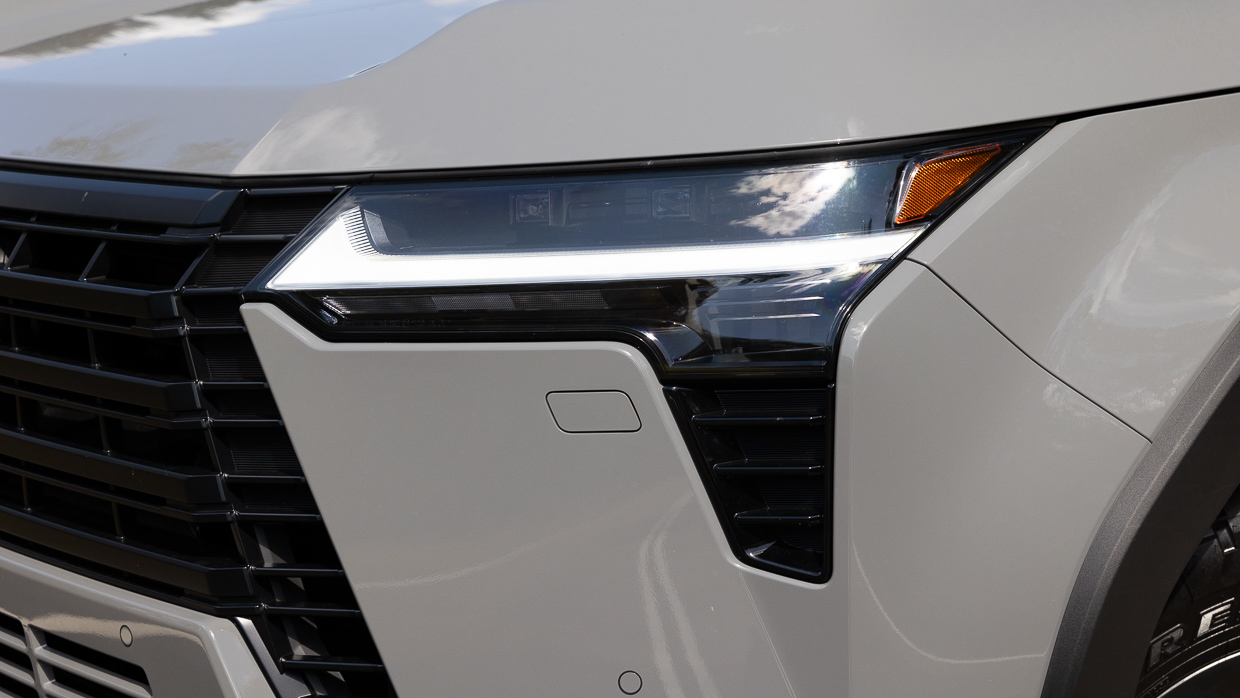
So, with the GX550 Overtrail on test, what are you getting for your circa-$134,000 driveaway? Here’s what is standard:
- 260kW/650Nm 3.4-litre twin-turbocharged petrol V6 engine
- 18-inch matte black alloy wheels
- 265/70 R18 Toyo Open Country A/T tyres
- Adaptive variable suspension
- Electronic Kinetic Dynamic Suspension System (eKDSS)
- Full-time four-wheel drive with dual-range transfer case (low range)
- Locking centre differential and locking rear differential
- 10-speed automatic transmission
- Multi-stage Crawl Control
- Overtrail-specific exterior design with black exterior trim
- Stand-off black roof rails
- Window treatment
- Triple-beam LED headlights with self-levelling functionality
- LED taillights
- Porthole opening sunroof
- Keyless access to front doors and tailgate, push-button start, smart key
- ‘Nuluxe’ artificial leather seat upholstery with Ultrasuede highlights
- 10-way power-adjustable driver’s seat with three-position memory
- 8-way power-adjustable passenger seat (no lumbar adjustment)
- Heated and cooled front seats
- Tsuyasumi charcoal film or oak wood interior trim
- 14.0-inch central touchscreen with Lexus Interface operating system
- 12.3-inch digital instrument cluster
- Wireless and wired Apple CarPlay and Android Auto
- 10-speaker Panasonic stereo
- Tri-zone climate control air conditioning
- Refrigerated cool box in the centre console
- Smartphone app (lock/unlock, climate control features) and Lexus Connected Services
- Front and rear parking sensors
- 360-degree camera
- 80-litre fuel tank
- Full-size alloy wheel and matching tyre, underslung at rear
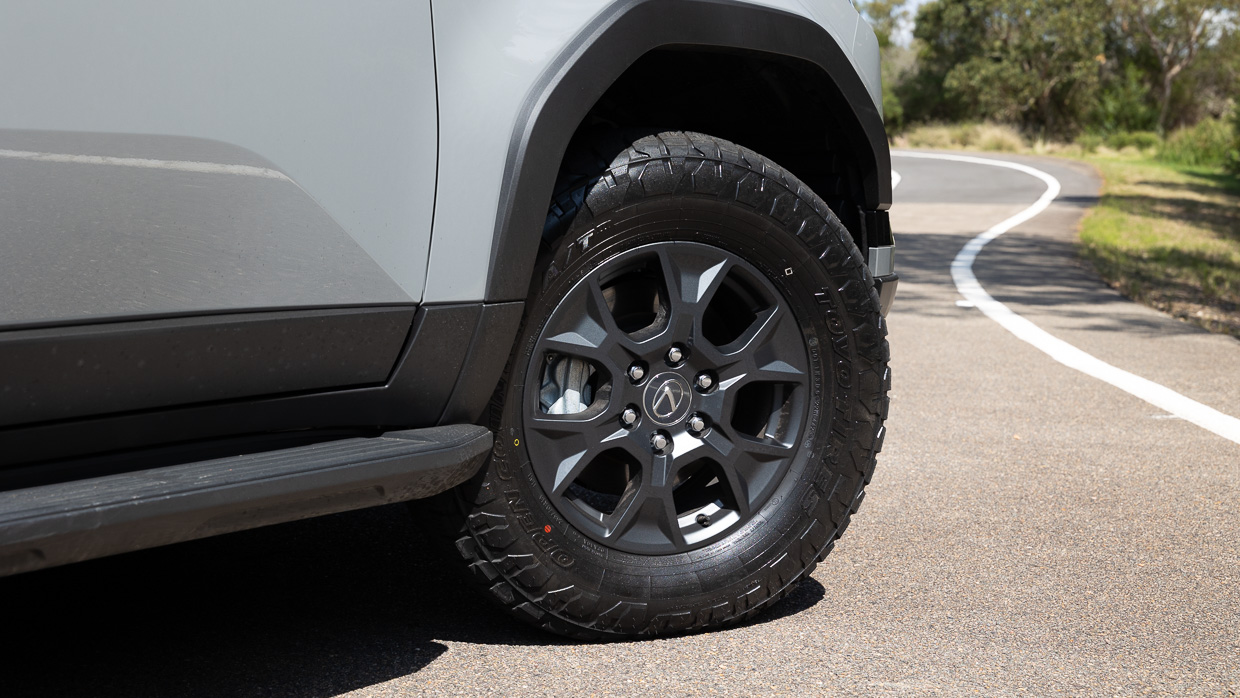
Over and above the approximately $6000-cheaper (on-road) Luxury grade, the Overtrail gains very little in the way of convenience spec. But the upgrade price is actually a bargain if you’ll get use out of the dedicated off-roading mechanical upgrades (tyres, locking rear diff, eKDSS, et cetera) or, of course, if you simply think it looks cool.
Spending $7000 more on the Sports Luxury loses the Overtrail’s off-road obviousness, reverting to more luxurious styling. Upgraders nab 22-inch multi-spoke alloys, power side steps, semi-aniline leather trim, massaging front seats, 21-speaker Mark Levinson premium stereo, a digital rear view mirror, heated steering wheel and a fixed panoramic glass roof.
The sole extra for the Overtrail on test is colour. Graphite Black solid paint is included, but other hues attract a premium: $1750 for Sonic Quartz (white) with matching roof, or a hefty $4200 for the remaining colours which exclusively fit a contrast black roof: Titanium Carbide (flat grey), Titanium (silver), Khaki Metal (green), or Moon Desert (sand beige).
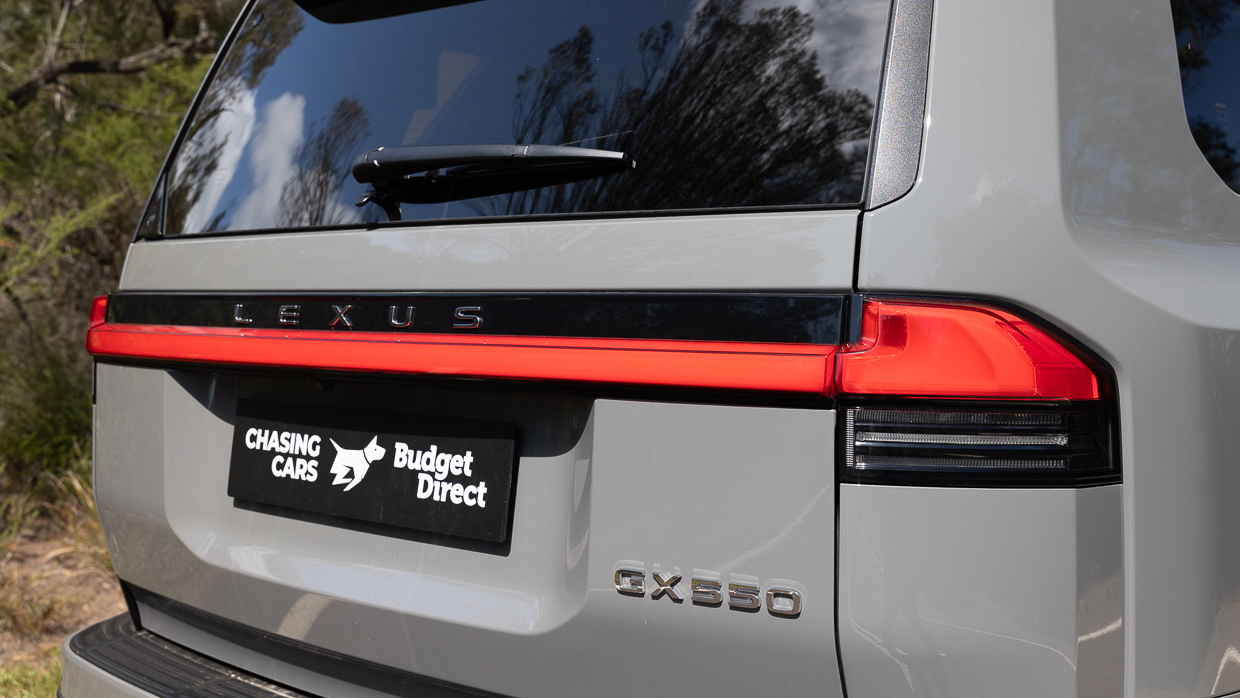
Inside, you also have to choose, at no additional cost, a seat upholstery colour. Black ‘Nuluxe’ trimming (with subtle olive green Ultrasuede highlights) is standard, with a choice of Tsuyasumi charcoal film trim or oak wood. Alternatively, buyers can opt for a ‘Chateau’ colour (black and sand two-tone) with Tsuyasumi trim.
For our money, we actually think the Overtrail is the sweet spot. Aesthetically, it delivers on the GX’s promise of rugged luxury – and it’s genuinely capable when the going gets very rough, too. For the modest step up from the Luxury, it makes sense. We’d go Khaki Metal or Moon Desert over Chateau.
How does the GX550 Overtrail drive?
There’s something about the way the GX550 drives that is viscerally appealing. After a week of testing, we think it’s the blend of the GX’s commanding driving position, generous grunt, and handling that is easier and more polished than what drivers can normally expect from frame-based 4WDs.
First, there’s the sensation that you can really see out of this vehicle. Unlike so many modern SUVs, this rig doesn’t give any quarter to curvy, aerodynamic styling that compromises visibility. It’s a large box, with a lot of glass. You sit high, with low window sills, like an old-school Range Rover. It’s a king-of-the-road mindset up here.
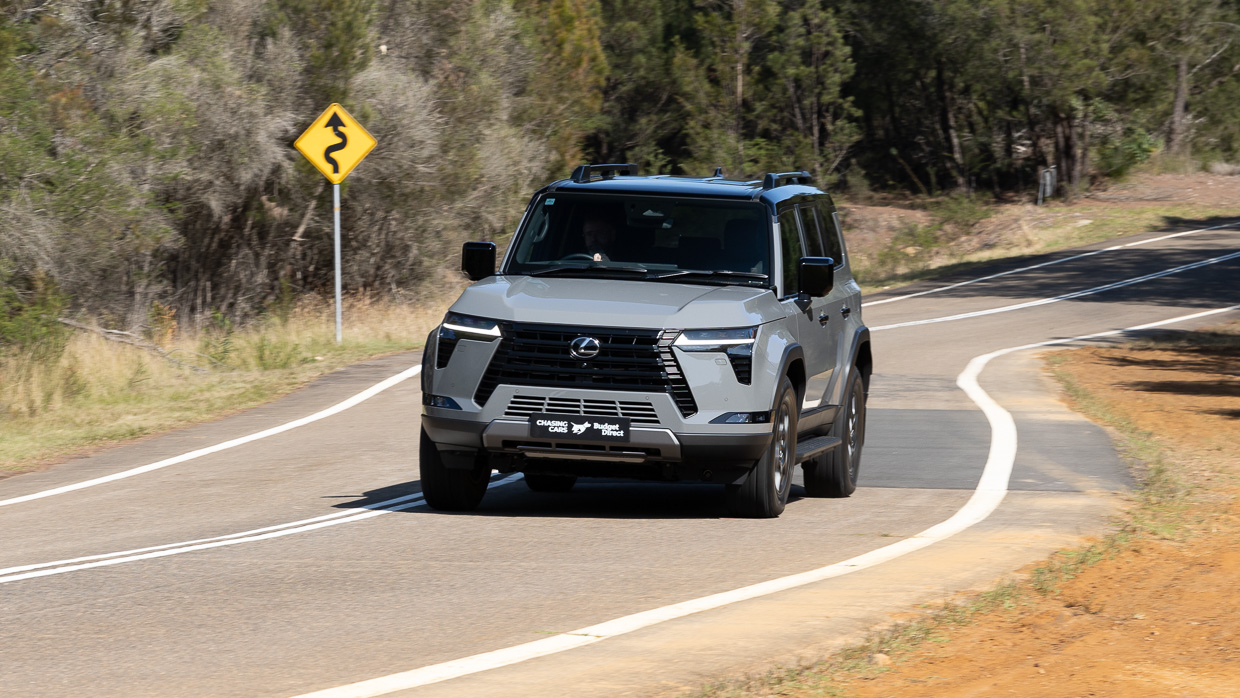
Narrow and tall mirrors aside (you get used to their field of view), the GX is immediately refreshing in its conventional design. And it’s pragmatic: looking ahead, two bulges appear at the outer edge of the bonnet. Those bulges perfectly line up with the tyre width, so you know precisely where you’re putting your wheels. Thoughtful.
Beneath that bonnet is the source of considerable envy for new Land Cruiser Prado buyers: massive delineation exists between the Toyota and Lexus interpretations of this chassis.
While the Prado soldiers on with a 2.8-litre turbo diesel four-cylinder making 150kW/500Nm, the GX nabs a 3.4-litre twin-turbo petrol V6 with 260kW/650Nm! (Yes, at 3445cc, Lexus rounds up to 3.5L in marketing.)
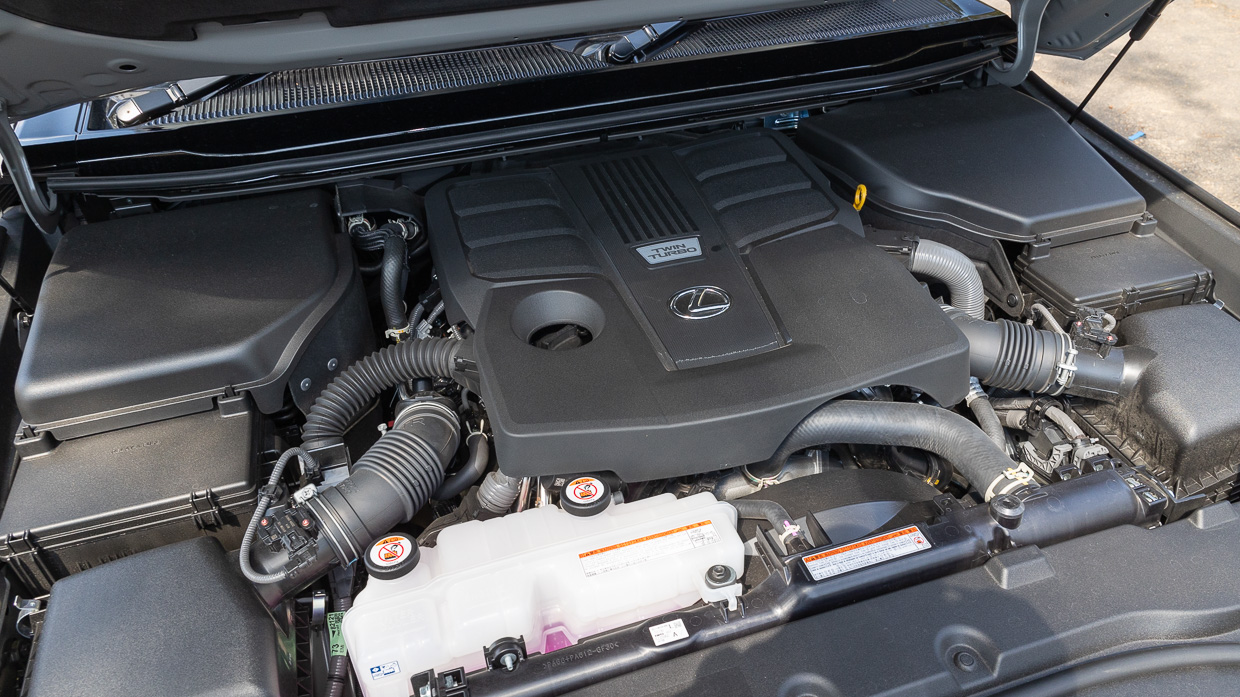
We haven’t yet tested the new Prado, but its diesel ‘four is a carryover (aside from a new mild-hybrid system). Based on our experience of that unit, we can picture how back-to-back test drive of a Prado Kakadu ($99,990) and, say, an entry-level GX Luxury ($116,000) will go. We suspect many will smash the piggy bank to find an extra $16K!
Our suspicions are grounded as much in data as they are in seat-of-the-pants feel. Chasing Cars performance-tested the GX550 Overtrail and determined its 0-100km/h time to be 6.24 seconds – at least four seconds quicker than the Prado. And keep in mind, that’s on Toyo Open Country all-terrain tyres, not the street tyres you get on other trims.
Out on the road, grunt is never lacking. Despite the GX’s boxy shape, bury your right foot on the loud pedal and the GX550’s 10-speed automatic transmission promptly finds a lower gear and runs – making a pleasant (but muffled) roar as it does so. Merging onto fast-moving highway or overtaking B-doubles is a stress-free experience.

We know not to look gift horses in the mouth, but we suspect the 3.3-litre twin-turbocharged V6 diesel fitted to the LX500d (and 300 Series Land Cruiser), making 227kW/700Nm, would be an even better fit in the GX.
Having good performance on-call is one of the reasons the petrol V6 GX makes for an effortless country tourer. Aside from some wind whistle around the upright mirrors, it’s a pretty refined experience…aside from the fact you have to stop far more frequently than you should (as discussed in the Ownership Costs segment below).
When we tested the GX in Arizona, we had concerns about the ride quality. Those worries dissipated to some degree back on Australian roads. While the GX exhibits some typical ‘fidget’ associated with frame-based wagons, it isn’t to a frustrating degree, and within a few days, you’re used to the subtle pitter-patter over road imperfections.
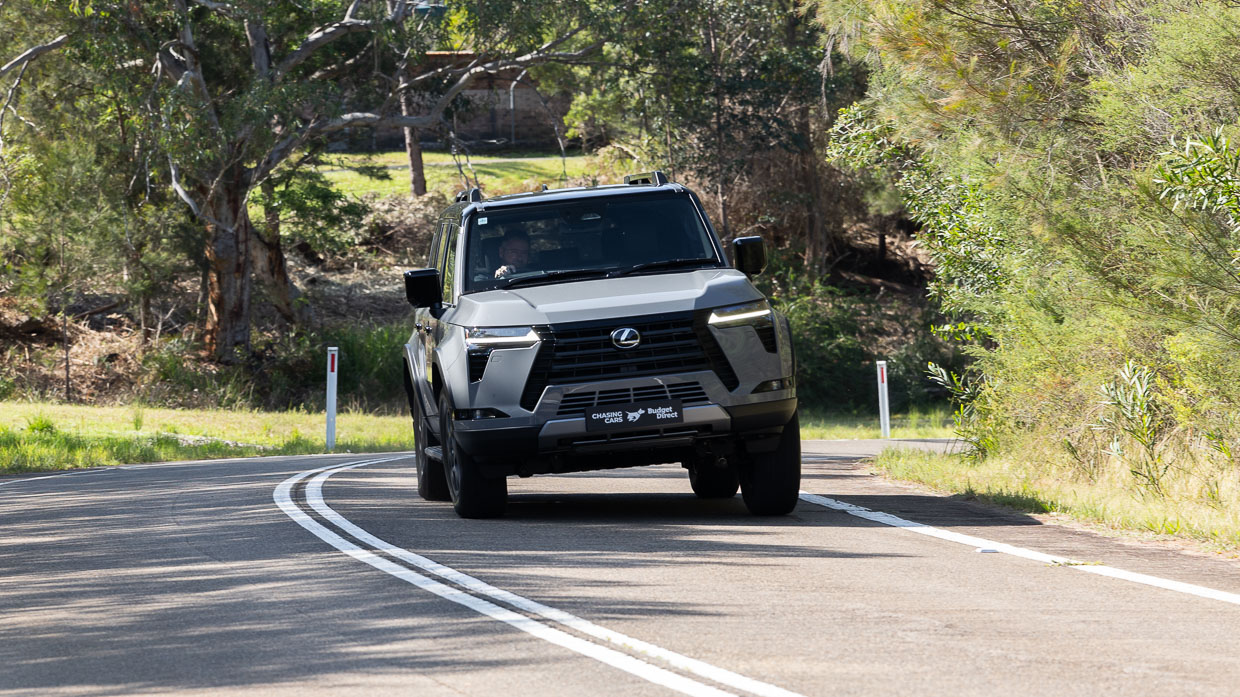
The compliance is never going to be in league with car-based SUVs like the Audi Q7, BMW X5 or Volvo XC90 (or even the unibody-construction Land Rover Defender) but for a serious 4WD, it’s pretty decent – we think it’s better than the larger and considerably more expensive LX, in fact.
So’s the steering: it’s clear that Lexus has put considerable development effort into getting the steering to feel remarkably car-like, and the fitment of a small-diameter steering wheel enhances the psychological effect. There is expected body lean in the corners, but on the whole, the GX handles crisply and can even be hustled along B-roads in a prompt manner.
Mechanically, the GX has coil springs all-round with a double wishbone independent front suspension and a five-link solid rear axle. The Overtrail trim goes further, adding valved, adaptive variable shock absorbers and Toyota’s e-KDSS system that electronically adjusts the GX’s sway bars to situationally limit body roll, or enhance wheel articulation.
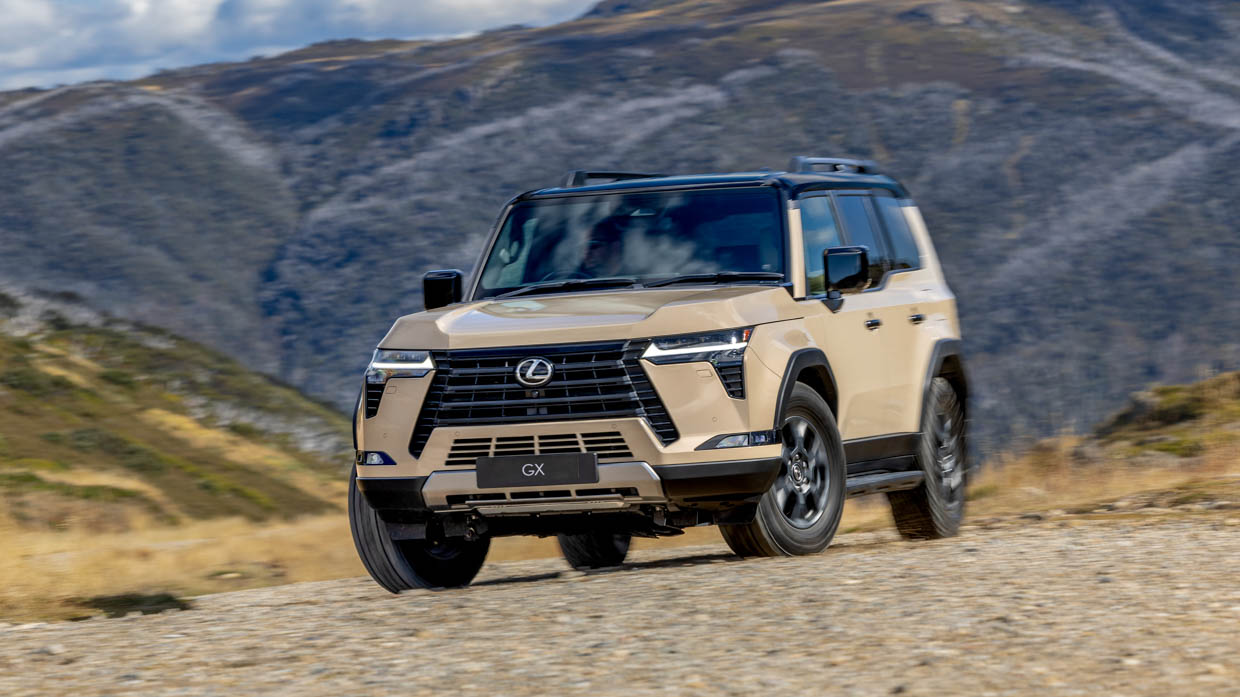
The fitment of e-KDSS is becoming increasingly rare in any Toyota Motor Corporation vehicle: no new Prado has it, for instance, while only the very top trims of the full-fat Land Cruiser 300 Series fit the tech locally – the GX550 Overtrail becomes the most affordable way to access e-KDSS in a brand-new vehicle.
The GX’s off-roading specs are decent. I’ve tackled tough obstacles in the vehicle (including gnarly moguls to demonstrate e-KDSS). But there is room for improvement: 225mm ground clearance trails a Defender’s air-sprung 290mm max. Wading depth is 700mm; the approach angle is 26 degrees, breakover 24 degrees, and departure 22 degrees.
What is the GX550 Overtrail’s interior and tech like?
There is immediate cohesion between the squared-off exterior aesthetic of the GX and the construction of the interior, which echoes the external forms with an almost eighties-style rectangular dash layout. It isn’t quite retro, but it certainly echoes memorable four-wheel-drive styling of decades gone by.
It’s similar to the forthcoming new Prado in that way, but the pair have been executed with many differences – and there is significant differentiation to the GX interior, with only hints of shared hard points and similarities in the infotainment system’s layout and look. Lexus fits its own seats, cabin materials, knobs, switches, dials, controls and more.

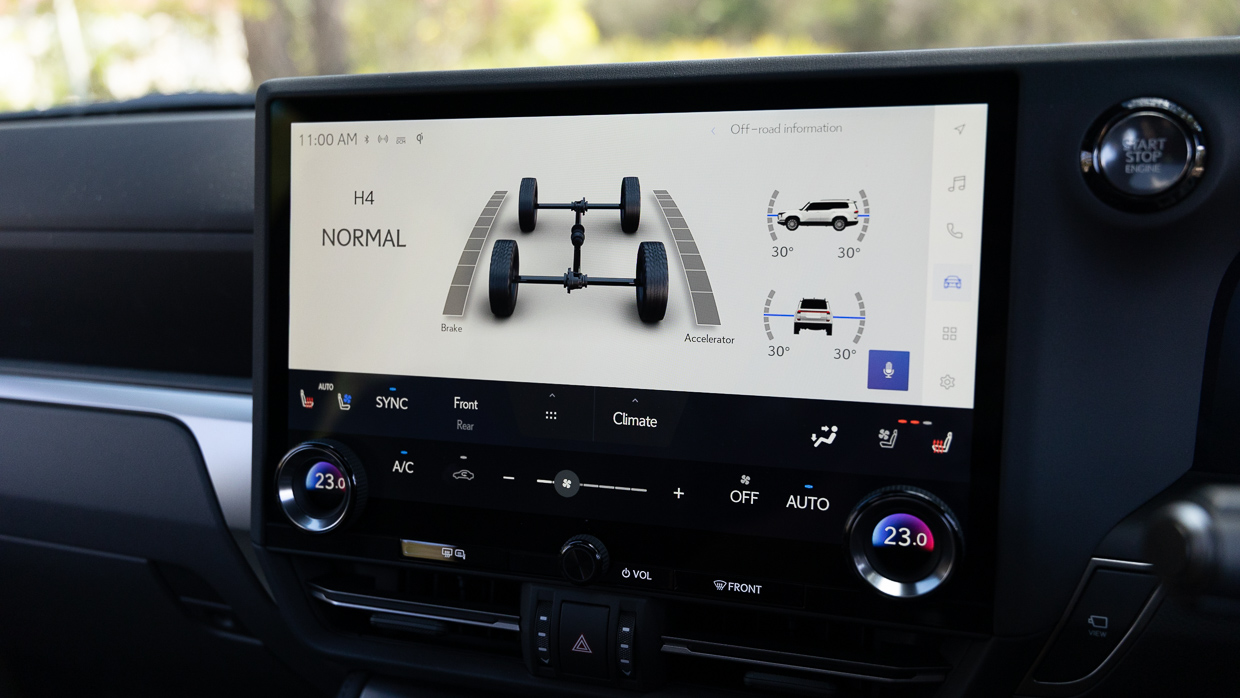
You climb up into a GX, assisted by its side running boards. It’s a very high seating position (affording great visibility on the road), with the dashboard and door sills sitting lower than your shoulders.
The ergonomics immediately work, with the compact, leather-wrapped steering wheel and gear shifter both falling easily to hand. And it’s a stark comparison between the interiors of the GX and LX – the latter suddenly looks busy and complicated while the simplified GX actually gives off a more subtle and premium appearance.
Materials immediately feel Lexus-grade to the touch, and the extent of plush textures reveals itself over time – it might look rugged and tough but it still cossets. Still, the GX won’t be confused for grandfather’s Lexus: there’s no glossy woodgrain in here and, on the whole, the colour palette is extremely subdued (perhaps even too subdued for some).

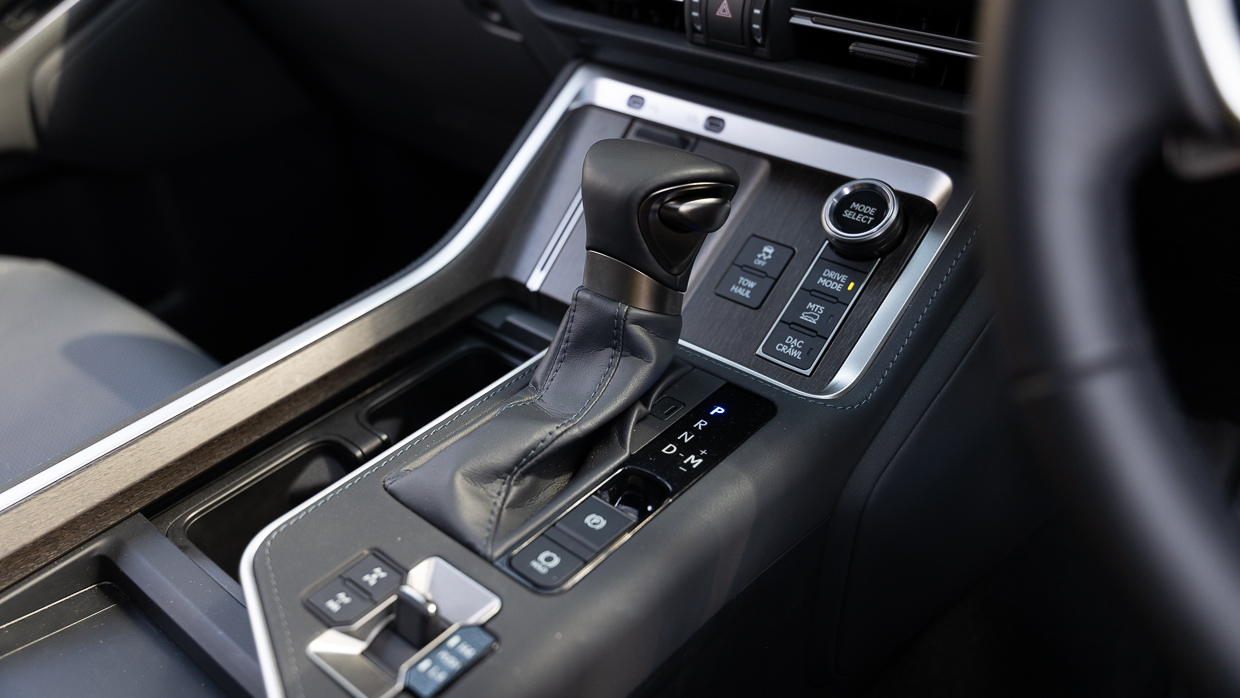
Black is fitted to the seats, dash and headliner of all GX trims. Lightening the cabin isn’t easy, though each grade offers the option of two-tone seats with black outers complemented by Dark Grey centres (Luxury), ‘Chateau’ brown centres (Overtrail), or ‘Hazel’ tan centres (Sports Luxury).
If you want a Lexus four-wheel drive dripping in light beige leather glossy burled wood, you can still have it – but only on the larger and dearer LX. The dark-theme GX, by comparison, is more youthful and broody.
The front seats of the GX (which have a stiffened base on the Overtrail only) are supportive across multi-hour driving and, for the driver, offer reasonable 10-way adjustment (including in-out lumbar). But the lack of up-down lumbar for the driver – and the total lack of lumbar adjustment for the front passenger – strike us as cheap exclusions for a car of this price.

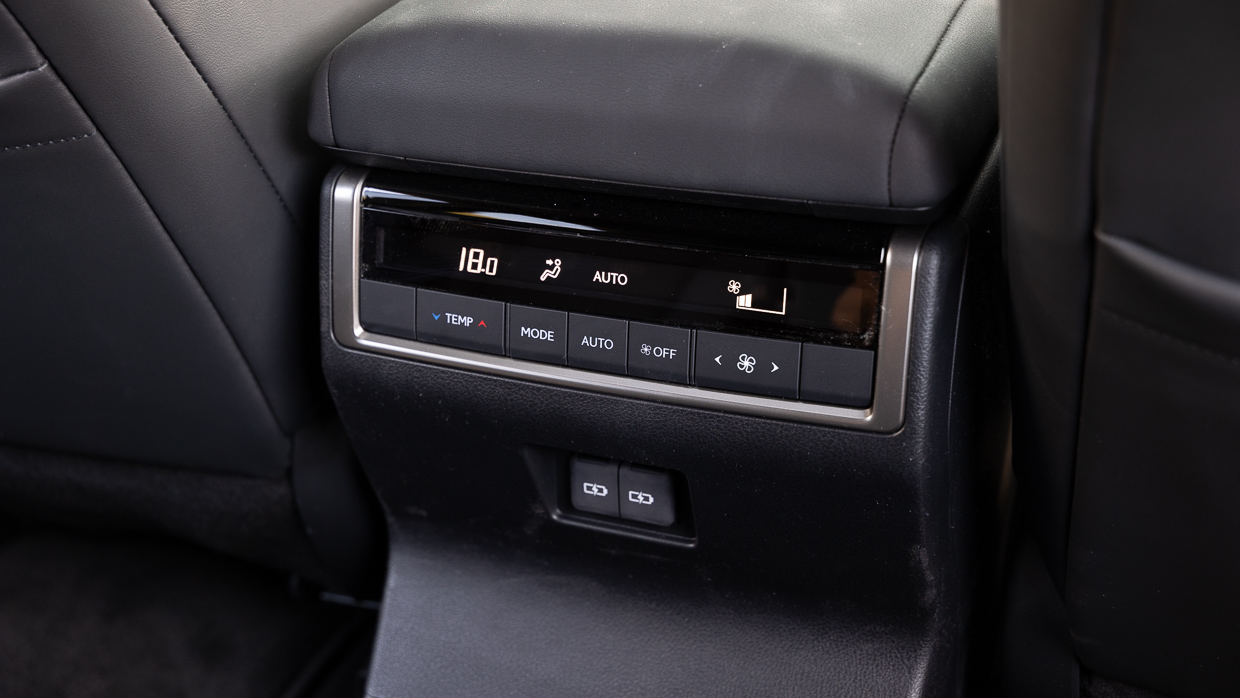
That omission joins a short list of omissions Lexus doesn’t usually forget. Also missing is keyless access for the rear doors (meaning you have to swipe a front door handle first) and rear-row sunblinds. We also find it strange you can’t option a typical Lexus enhancement pack to the Overtrail to give it, for instance, Mark Levinson audio and a digital rear mirror.
Still, the standard-fitment 10-speaker Panasonic stereo sounds remarkably decent with some tuning of the EQ, and on the whole, the Lexus infotainment system works well. We appreciate the fact that the driver’s 12.3-inch screen is inset within the dash rather than proud and cowl-less like so many newer cars.
From where we sat, the outer corners of the large 14.0-inch slate touchscreen required a bit of a stretch, and that central screen could get glary – but the menu system was intuitive and wireless Apple CarPlay (or Android Auto) paired up quickly and reliably each time. There are dials for temperature and volume but fan speed requires a touchscreen tap.

As you’d expect, the air conditioning of this Toyota Motor Corporation product is exceptionally good and cold while the Overtrail scores an effective coolbox between the seats for keeping a sandwich and a few drinks cold on a long drive.
Moving to the back seats, space is acceptable, not outstanding. Six-foot adults fit, but legroom isn’t generous, and the combination of a high floor and low seat base conspire to rob second-row passengers of leg support.
Sadly, the Overtrail can’t even be optioned as a seven-seater – meaning bigger families will have to opt for the Luxury or Sports Luxury.

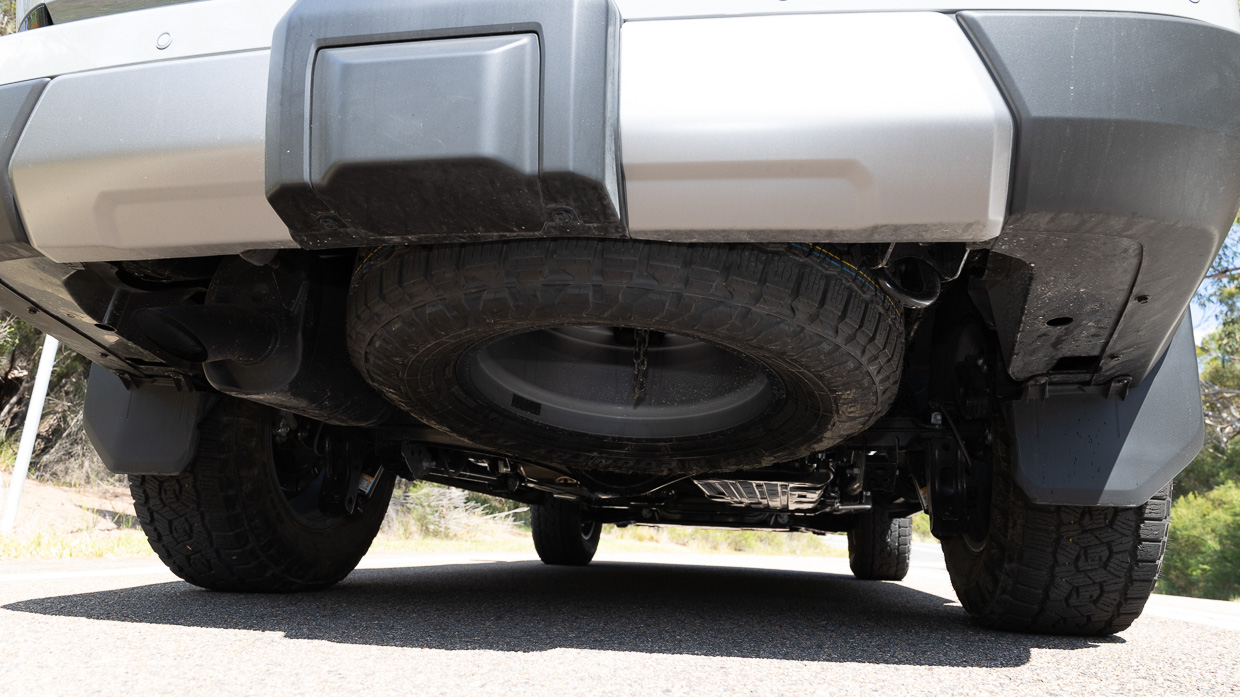
Boot-wise, we like that the tailgate glass can be opened separately to the door, allowing smaller items to be thrown in without waiting for the power liftgate to open.
Boot space is a claimed 1063 litres (VDA) behind the second row, which can also be folded to liberate 2000L. A household power point is found in the cargo area, while a full-size matching spare wheel and tyre is underslung.
Is the GX550 Overtrail a safe car?
Australia’s new car safety and crash testing body ANCAP has not tested the new Lexus GX. It’s not sold in Europe, and complicating matters, America’s IIHS ratings body hasn’t yet tested the vehicle either. So when it comes to objective ratings we are in the dark for the time being.
We can take some reassurance from the fact that another GA-F platform vehicle has been tested by ANCAP in-country: the Toyota Land Cruiser 300 Series, which scored five stars back in 2022. That’s not a guarantee that the GX will do the same, but it is an indicator the platform itself is up to scratch.
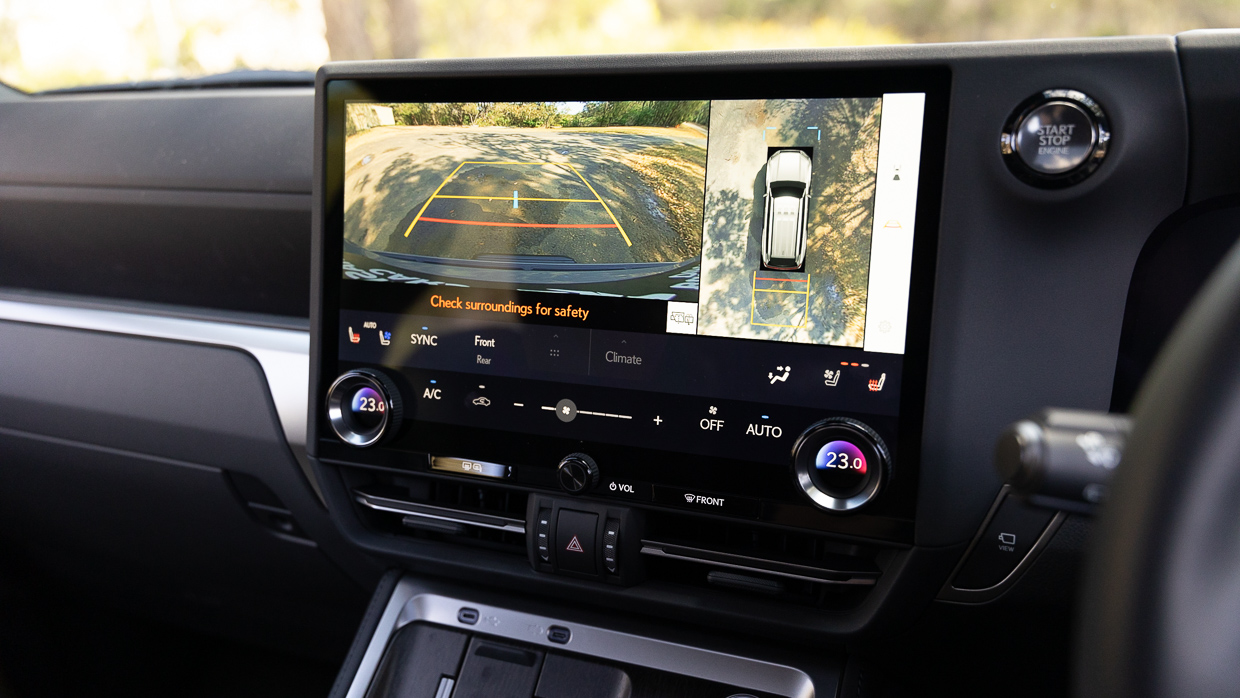
The following safety features are fitted as standard to the GX:
- Lexus Safety System+ suite
- Autonomous emergency braking (AEB) with pedestrian, cyclist, motorcycle and vehicle detection (including at junctions)
- Reversing AEB
- Adaptive cruise control
- Lane trace assist
- Blind spot monitoring with rear cross traffic alert
- Traffic sign detection
- Driver monitoring camera
- Front and rear parking sensors with 360-degree camera
- Tyre pressure monitor
During our road test, we appreciated the clarity and sharpness of the 360-degree parking camera, making it easier to maneouvre the GX into parking spaces. The tuning of the adaptive cruise control was very smooth while the blind spot monitoring also worked well.

While Lexus fits lane departure warning and lane tracing assistance to the GX, like other GA-F vehicles we’ve tested, we found the tracing function had spotty functionality. The lane keeping would generally kick in as the vehicle drifted to the lane marking, and its operation was a rough. Hence, we found ourselves turning it off with two taps of the touchscreen.
What are the GX550 Overtrail’s ownership costs?
The big downside to Lexus fitting a honkin’-great twin-turbo V6 petrol engine to the GX is, unsurprisingly, what it does to running costs.
To be fair, Lexus doesn’t claim that the GX550 is efficient! The claimed consumption is 12.3L/100km, and as usual, the claim is more or less achievable – but only on the open road, where we saw 12.0L/100km. In town, our result was 17.5L/100km – meaning every 100km of urban school-running (for instance) will cost a steep $40 or thereabouts in fuel.
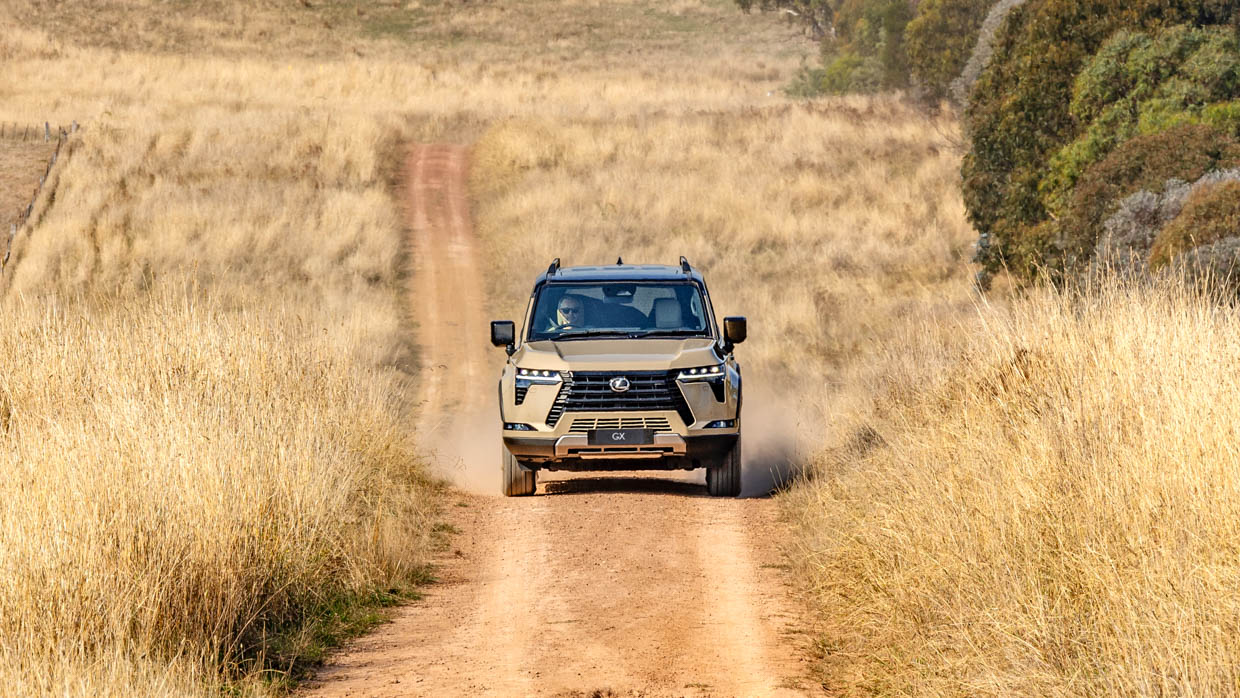
A hybrid GX is in development and will almost certainly come to Australia, but it’ll probably be the 2.4-litre turbo petrol four-cylinder parallel hybrid setup seen in the Lexus RX500h rather than a really miserly fuel-sipper.
But being costly to fuel is one thing. Being inconvenient to fuel is quite another. And the GX is – because you have to stop so often. For some reason, Lexus signed off on a small (relatively speaking) 80-litre fuel tank for the GX550, despite its prodigious thirst. Based on our tested efficiency, that means a range of 666km (highway) or 457km (urban).
It’s almost painful to think of how things might have been different had Lexus gone the extra mile and offered the company’s V6 diesel powertrain. Our experience suggests the diesel uses more like 9.0L/100km to 13.0L/100km, which would have meant a noticeably more useful range of 615km to 888km even with the same compact fuel tank.

The other option would perhaps be to sell the GX with an old-school, tailgate-mounted spare wheel and tyre, opening up space for an additional fuel tank that would boost range through sheer capacity for the GX550’s required 95-octane (minimum) petrol.
On the servicing front, like other Land Cruiser products, scheduled maintenance comes up every six months or 10,000km (not annually like nearly all car-based SUVs). Lexus does cap the price of the first 10 services, resulting in a five year/100,000km total servicing cost of $5950.
Warranty for the GX is the standard five year/unlimited kilometre program offered on all Lexus vehicles.
The honest verdict on the GX550 Overtrail
The GX is one of the best-executed Lexus models in years. While it retains the brand’s signature premium touches, this four-wheel drive is honest, rugged and fit for purpose. It looks cool, offers solid performance, drives well, is well specified, and is based on a dependable platform and chassis.
That said, there are two clear ways Lexus could improve the GX. It could add the option of the 3.3-litre turbo V6 diesel available in the 300 Series for a peachy balance of power and efficiency. And, at the very least, it could examine ways to increase the fuel tank size to extend the paltry range of the GX550 petrol model.
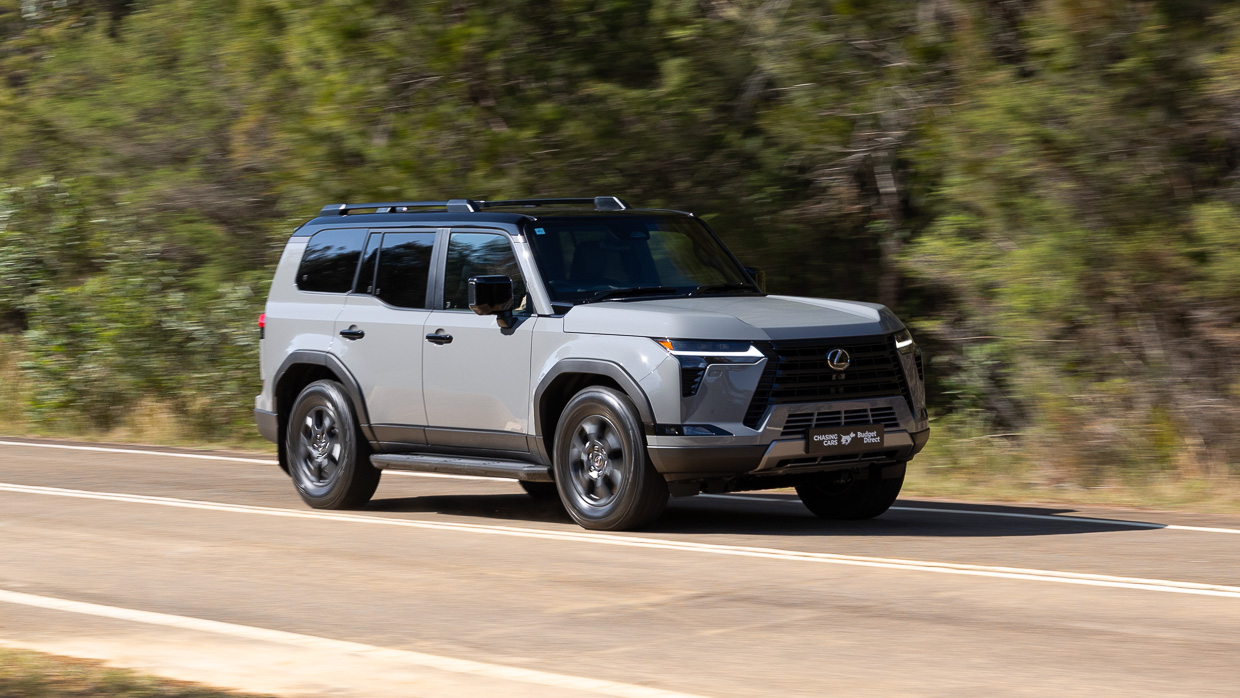
We know that Lexus is working on a turbo-petrol hybrid engine for the GX and that could be an interesting alternative, but if it were up to us, we’d keep it simple by introducing a GX500d V6 diesel.
But even if a diesel, hybrid or larger fuel tank come to fruition, we wouldn’t regard these omissions as dealbreakers. Frankly, we’d put up with the inconvenience of stopping for fuel every 600km or so – because the GX experience is so good that it’s worth the minor headache.



